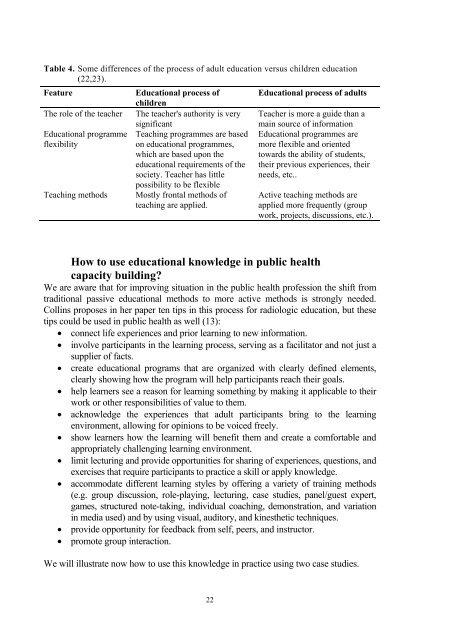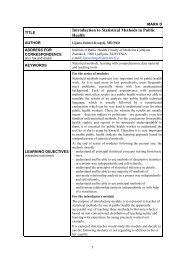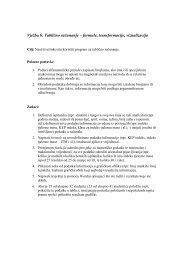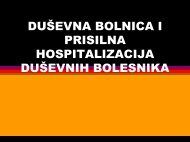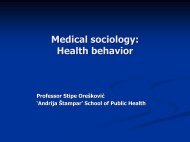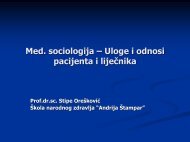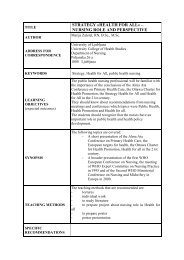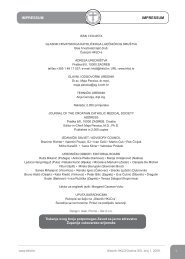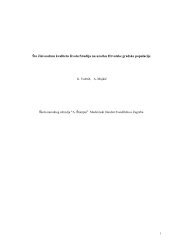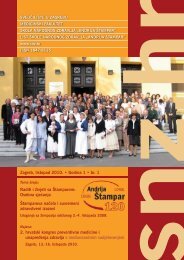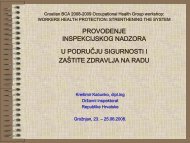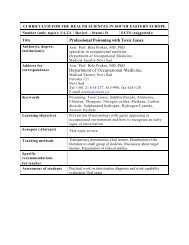STATISTINE METODE V EPIDEMIOLOGIJI
STATISTINE METODE V EPIDEMIOLOGIJI
STATISTINE METODE V EPIDEMIOLOGIJI
Create successful ePaper yourself
Turn your PDF publications into a flip-book with our unique Google optimized e-Paper software.
Table 4. Some differences of the process of adult education versus children education<br />
(22,23).<br />
Feature<br />
The role of the teacher<br />
Educational programme<br />
flexibility<br />
Teaching methods<br />
Educational process of<br />
children<br />
The teacher's authority is very<br />
significant<br />
Teaching programmes are based<br />
on educational programmes,<br />
which are based upon the<br />
educational requirements of the<br />
society. Teacher has little<br />
possibility to be flexible<br />
Mostly frontal methods of<br />
teaching are applied.<br />
Educational process of adults<br />
Teacher is more a guide than a<br />
main source of information<br />
Educational programmes are<br />
more flexible and oriented<br />
towards the ability of students,<br />
their previous experiences, their<br />
needs, etc..<br />
Active teaching methods are<br />
applied more frequently (group<br />
work, projects, discussions, etc.).<br />
How to use educational knowledge in public health<br />
capacity building<br />
We are aware that for improving situation in the public health profession the shift from<br />
traditional passive educational methods to more active methods is strongly needed.<br />
Collins proposes in her paper ten tips in this process for radiologic education, but these<br />
tips could be used in public health as well (13):<br />
• connect life experiences and prior learning to new information.<br />
• involve participants in the learning process, serving as a facilitator and not just a<br />
supplier of facts.<br />
• create educational programs that are organized with clearly defined elements,<br />
clearly showing how the program will help participants reach their goals.<br />
• help learners see a reason for learning something by making it applicable to their<br />
work or other responsibilities of value to them.<br />
• acknowledge the experiences that adult participants bring to the learning<br />
environment, allowing for opinions to be voiced freely.<br />
• show learners how the learning will benefit them and create a comfortable and<br />
appropriately challenging learning environment.<br />
• limit lecturing and provide opportunities for sharing of experiences, questions, and<br />
exercises that require participants to practice a skill or apply knowledge.<br />
• accommodate different learning styles by offering a variety of training methods<br />
(e.g. group discussion, role-playing, lecturing, case studies, panel/guest expert,<br />
games, structured note-taking, individual coaching, demonstration, and variation<br />
in media used) and by using visual, auditory, and kinesthetic techniques.<br />
• provide opportunity for feedback from self, peers, and instructor.<br />
• promote group interaction.<br />
We will illustrate now how to use this knowledge in practice using two case studies.<br />
22


